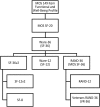Scoring the SF-36 in Orthopaedics: A Brief Guide
- PMID: 26446970
- PMCID: PMC5029523
- DOI: 10.2106/JBJS.O.00030
Scoring the SF-36 in Orthopaedics: A Brief Guide
Abstract
The Short Form-36 (SF-36) is the most widely used health-related quality-of-life measure in research to date. There are currently two sources for the SF-36 and scoring instructions: licensing them from Optum, Inc., or obtaining them from publicly available documentation from the RAND Corporation. The SF-36 yields eight scale scores and two summary scores. The physical component summary (PCS) and mental component summary (MCS) scores were derived using an orthogonal-factor analytic model that forced the PCS and MCS to be uncorrelated, and it has been shown to contribute to an inflation of the MCS in patients with substantial physical disability. Oblique scoring can reduce this inflation of the MCS in orthopaedic studies. Spreadsheets to score the SF-36, along with a copy of the questionnaire, are provided.
Copyright © 2015 by The Journal of Bone and Joint Surgery, Incorporated.
Figures

References
-
- Turner-Bowker DM, Bartley BJ, Ware JE. SF-36® health survey and “SF” bibliography. 3rd ed. Lincoln, RI: QualityMetric Incorporated; 2002.
-
- Tarlov AR, Ware JE Jr, Greenfield S, Nelson EC, Perrin E, Zubkoff M. The Medical Outcomes Study. An application of methods for monitoring the results of medical care. JAMA. 1989. August 18;262(7):925-30. - PubMed
-
- Stewart AL, Sherbourne CD, Hays RD, Wells KB, Nelson EC, Kamberg CJ, Rogers WH, Berry SH, Ware JE Jr. Summary and discussion of MOS measures. In: Stewart AL, Ware JE Jr, editors. Measuring functioning and well-being: the medical outcomes study approach. Durham, NC: Duke University Press; 1992. p. 345-71.
-
- Bindman AB, Keane D, Lurie N. Measuring health changes among severely ill patients. The floor phenomenon. Med Care. 1990. December;28(12):1142-52. - PubMed

